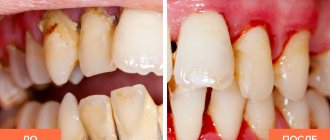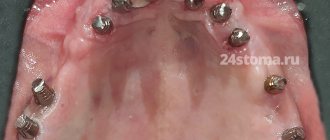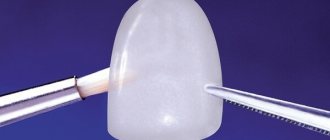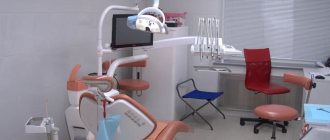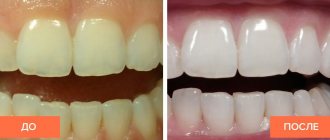A dental crown is a separate type of orthopedic structure used in dentistry to restore the shape, aesthetics and functional functions of a dental unit. Single crowns are used in the process of restoring severely damaged teeth: for example, if due to illness or injury the natural crown has been destroyed by more than fifty percent, it is more correct to restore it not with filling composites, but by installing a dental crown. Dental crowns are also actively used in prosthetics, for the restoration of missing units. Most often, a dental bridge is used for this purpose - a structure in which several dental crowns are connected. The finished prosthesis is fixed in the oral cavity on the supporting teeth, previously prepared to the thickness of the crowns. Bridges are used when there is a defect in a row with the absence of no more than two dental units in a row.
Calculate the cost of treatment by taking a short test in 20 seconds!
Do not delay your treatment, because in this matter time plays against us.
Photos of a single crown and dental bridge will help you get an idea of what the structures look like.
Before restoration with crowns, not only preliminary grinding of the supporting teeth is required: the teeth should be treated for carious damage, restored with a filling, and sometimes endodontic treatment may be required. Professional sanitation of the oral cavity is also recommended. All of the above measures allow restoration with crowns to be carried out with the highest possible quality, without the risk of complications in the future.
When is it indicated to install crowns on teeth?
The main indications for installing dental crowns are as follows:
- Severe destruction of the dental unit, in which the natural crown of the tooth has collapsed by more than fifty percent;
- In case of single defects in the dentition (when no more than two units in a row are missing in a row);
- Aesthetic restoration to achieve an attractive tooth color and shape.
Less commonly, crown prosthetics act as an alternative to orthodontic treatment in situations where it is necessary to change the position of one tooth in a row.
USEFUL TO KNOW: Teeth that are more than 50% damaged due to caries or for other reasons should be restored with a crown, not a filling. Large fillings installed quickly on pins fall out, and in addition, teeth filled under such circumstances usually come out of the bite, which can lead to its failure and disruption of the correct distribution of the chewing load.
An even worse option is that a tooth with a huge filling simply cannot withstand the pressure that occurs when chewing food and breaks, and if a pin is placed, the root of the tooth unit may also be damaged. Trauma to the tooth root suggests only one outcome - tooth extraction.
Prosthetics with crowns has not only indications for implementation, but also contraindications, which are important to exclude before starting the treatment process. Crowns are not installed:
- With mobility of the dental unit;
- Abnormally low height of the natural coronal part of the tooth, leading to the collapse of the orthopedic crown;
- When there are a significant number of teeth in rows.
It will be necessary to postpone restoration with crowns even if the diagnosis reveals an inflammatory process in the upper part of the root system of the tooth or poor-quality filling of its canals.
Under such circumstances, it will be necessary to take measures to eliminate temporary contraindications to crowns and only after that the restoration procedure itself.
When a front tooth cannot be saved
After a serious fracture, when the roots of the unit are destroyed due to caries, a protracted destructive process, immediate removal of the unit is required. Many are afraid of being left without a front tooth, but the clinic’s dentists remind: most patients are suitable for immediate implantation.
This is a way to extract and insert a tooth in one session: only one anesthesia is needed, two operations are combined into one. The price depends on the type of implant and related factors.
The tooth is removed and the implant rod is placed in the same hole, the gum is sutured. Many patients are indicated for immediate weight bearing. A temporary plastic crown is placed on the pin, replacing it after complete healing with a permanent model. In one visit you will lose your damaged tooth and acquire a new functional artificial root. The technique allows you to quickly return the tooth and not get upset when looking in the mirror.
Our clinics provide only high-quality care: we value your health and care about our own reputation. There is no point in saving on the main thing - we offer treatment in installments. We restore the smile area today, and the patient can take advantage of interest-free installments, paying for the treatment in installments.
Dental crowns: classification, overview of characteristics and prices for different types of crowns
The classification of dental crowns is carried out according to the material of production. Crowns made of metal alloys of various metals are in maximum demand: they are durable and at the same time have an affordable price for most patients. However, let us make a note - crowns made from alloys of ordinary metals - cobalt, chromium, nickel - will be inexpensive. Crowns made of precious metals are much more expensive and the price of the products will be directly related to their weight.
No less popular types of crowns are structures made of dental ceramics, which include crowns made of zirconium, porcelain, and lithium disilicate. Each type of product has its own unique performance characteristics, which will be useful to learn about in advance, if only because they will have an active influence on the price of the crown.
The cost of a crown per tooth varies from one dentist to another. At the current time, the price of a crown per tooth unit will be:
- Metal-ceramic crown - from 5 to 16 thousand rubles;
- Ceramics - from 16 to 25 thousand rubles;
- Metal crowns - about 5 thousand rubles.
USEFUL TO KNOW: Of course, the price of crowns may seem high, but it is wrong to think that it is so high only because dentists want to profit from patients. The cost of a crown depends on the cost of the material for its production and the complexity of the manufacturing technology. And the production material and technology - the strength of the crown, the timing and comfort of its operation will depend on these factors.
For example, the most inexpensive option is all-metal crowns. However, the aesthetics of such structures are extremely poor; they are practically not used for restorations in the smile area. Therefore, when choosing a crown, you should focus primarily not on the price, but on the result of the restoration you want to achieve. If aesthetics and the durability of the crown are important to you, you should choose crowns made from more expensive materials produced using computer modeling technologies. If the masticatory unit is restored with a crown, you can save money and choose a high-quality and at the same time budget option for the prosthesis.
Below we will consider in detail the features of different types of crowns and find out their approximate cost.
How long does it take to insert teeth?
Is it possible to get teeth inserted in one day so that you don’t have the reputation of a gap-toothed person? If you use modern methods of inserting teeth, you can get quick results. However, a lot depends on the condition of your oral cavity. She needs to be prepared for prosthetics. It is this stage that most often takes a lot of time. Before you insert teeth, they need to be made, and this takes time, because the prosthesis is made individually, based on a cast of your jaw.
Inserting temporary teeth in one visit is quite possible. At least you will not remain toothless for the period while your permanent denture is being made. If the task is not to replace the removed “unit”, but only to insert 1 tooth that is badly damaged, then you will have to visit the dental office several times. For example, you will have a ceramic tooth inserted, but before that:
- heal the root;
- the remains of the coronal part will be removed;
- they will take an impression of the stump inlay;
- they will make it;
- will install;
- the impression will be taken again;
- a crown will be made;
- will carry out a fitting;
- They will install a crown or return it to the dental technician for revision.
Here is the answer to the question: how many days does it take to insert teeth? From one day to several weeks, if we are talking about restoring a tooth from which a strong root remains. But how then are teeth inserted if there is no root? If bridge prosthetics is performed, then you can limit yourself to one impression, but it is unlikely that you will be able to insert teeth without turning the supporting “units”. And preparing teeth also takes time. So in this situation, one visit is not enough.
Today, more and more often there are proposals to insert teeth in one day and even put an immediate load on the implant, whereas previously it was believed that this titanium element must still take root in the human bone tissue before an abutment and crown are installed on it. And this sometimes took several months. What may have changed in technology to allow immediate loading of implants is worth exploring in more detail.
Metal-ceramic crowns: features, cost of prosthetics
The basis of this type of crown is a solid metal alloy frame, the average thickness of which is about 0.5 millimeters. From the outside, the metal base is covered with several layers of ceramic mass, which allows you to obtain an aesthetic appearance of the prosthesis, visually indistinguishable from natural teeth. The base can be made from both inexpensive metals and precious metals - gold and platinum.
USEFUL TO KNOW: In terms of price, a platinum crown is only slightly cheaper than a metal-free product, but at the same time its aesthetic indicators are lower, since even the precious metal will shine through the ceramics.
The advantages of metal-ceramic crowns include: reliability and durability, good aesthetics, affordable price (if we are not talking about products made of platinum or gold). The disadvantages of metal-ceramic crowns will be the following: before prosthetics, a significant amount of tissue is removed from the supporting teeth, teeth often need to be depulped first, and the gum tissue around the crown can acquire an unsightly bluish tint. This defect in metal-ceramic crowns is especially noticeable and critical when performing prosthetics in the smile area.
USEFUL TO KNOW: The defect of cyanosis of the gums occurs due to contact of the crown with soft tissues. To avoid the occurrence of such an unpleasant phenomenon, you can order in advance the production of a prosthesis with a shoulder mass, in which the lower part of the base of the product is also covered with a layer of ceramics. Prostheses with shoulder mass have a more complex production technology, and therefore their price is higher than for conventional crowns.
Having understood the features, advantages, and disadvantages of metal-ceramic crowns, we can move on to considering their cost. On average, a crown of this type, made of high-quality alloy, will cost about 8,000 rubles. If expensive ceramic materials are used for veneering the crown, allowing for high aesthetics of the product, the price of the crown will be higher and can amount to 10 thousand rubles.
The price of crowns with shoulder mass will be even higher - from fourteen thousand. Prices for metal-ceramic crowns may be lower - 5-6 thousand rubles, but usually at this price they offer products in the production of which domestically produced materials were used. Let’s be honest, the domestic product does not meet European quality standards, and therefore the finished crowns will not be distinguished by high levels of aesthetics and reliability.
Crowns with a base of gold or platinum cost about 10 thousand rubles. But the indicated amount is the cost of manufacturing the prosthesis, to which should be added the price of the precious metal per gram of weight. As a result, the price of the crown is already a different amount - from 18 thousand rubles.
It is important to note: the price of crowns does not include pre-treatment services and the cost of a temporary prosthesis.
Is it possible to insert teeth without grinding down the adjacent ones?
Before installing classic dentures with fixation on natural teeth, preparation is required. Without grinding, restorative procedures are carried out using plastic structures with special clasp hooks that clasp the neck of a healthy tooth and thus hold the prosthesis in the oral cavity. The production and installation of such prostheses occurs much faster than in the case of overlay prostheses on implants, but you should not count on recovery in one day. If we are not talking about temporary prostheses, the creation of structures, fittings, and corrections can take several weeks.
Ceramic (metal-free) crowns: overview of types, performance properties and prices
The main difference between such crowns and metal-ceramic analogues is that they are produced without a cast metal alloy frame and this gives two advantages at once: high aesthetics and the possibility of using crowns in patients with allergies to metals. The aesthetic and most natural appearance is ensured by the translucency of the ceramic; according to this property, the material will be almost identical to natural tooth enamel.
USEFUL TO KNOW: Opaque ceramic masses are used for veneering metal-ceramic crowns, and therefore the finished crown will look somewhat unnatural.
Ceramic crowns can be made from zirconium dioxide or E.max glass ceramics. Both crown materials have high levels of transparency and therefore products made from them will look natural and visually indistinguishable from natural teeth.
Indications for use
The main reasons for the absence, for the elimination of which the dentist will suggest installing a crown on the tooth, include:
- destruction by 50% (both as a consequence of advanced caries and mechanical impact);
- the aesthetic side associated with the occurrence of chips, cracks, deterioration of color compared to the rest of the “brothers” in the series;
- damage to the coronal part (in other words, destruction of the installed prosthesis);
- critical abrasion - bruxism is a pathological disorder in which intervention will serve as protection for tissues.
Important! Bruxism is an involuntary grinding of teeth that occurs in people during nighttime sleep. First, the doctor will recommend undergoing a full diagnosis and treating the cause of the deviation, taking a course using a night guard, before direct placement.
Zirconium crowns
An innovative CAD/CAM manufacturing technique is used to produce zirconium dioxide crowns. It allows the production of orthopedic structures with minimal human intervention. Crowns are turned using milling equipment, and their layout is made using special computer technologies.
Zirconium is a unique material; it not only has optimal biocompatibility with the human body, but also high strength, comparable to the strength of metal. The cost of zirconium crowns starts from 16 thousand rubles.
Two types of zirconium crowns can be used for restoration and prosthetics:
- Two-layer, that is, consisting of a zirconium frame, which is subsequently covered with ceramic mass. The use of this type of crown allows you to obtain the most aesthetic result of restoration, but there is also a minus - if used incorrectly, the ceramics from the frame may chip and the prosthesis will have to be restored;
- Monolithic crowns are machined from solid zirconium blocks and do not have a porcelain outer layer, but in terms of aesthetics they will be significantly inferior to the first type of product.
If prosthetics are performed in the area of the front teeth, where aesthetics are important, glass-ceramic crowns may be the best choice.
How is an implant inserted?
The essence of this technique is to implant a titanium root into the jaw, on which a crown is subsequently installed. On average, implant healing takes from 2 to 6 months. During this time, a temporary orthopedic structure is installed for the patient’s convenience.
There are protocols for immediate implantation. Modern structures can be inserted after tooth extraction and immediately loaded with a prosthesis. Many patients are interested in whether it is painful to insert a dental implant. In fact, implants are installed quite quickly (15 - 20 minutes per tooth), and an injection of anesthesia allows you not to feel pain. If you have severe dental phobia, the doctor will suggest inserting teeth under anesthesia or sedation.
Glass-ceramic crowns E-max
Glass-ceramic crowns are an excellent option for those who want to get the most aesthetic results from prosthetics. The cost of one E-max crown is from twenty thousand rubles.
Despite all the advantages, glass-ceramic crowns have one significant disadvantage: they are applicable only in the case of single defects in the dentition. A bridge can also be made from glass-ceramics, but with no more than three crowns, and it is fixed in the area of the front teeth. These limitations are associated with the strength of glass ceramics, which will be insufficient for a massive bridge, which will also be subject to significant load (during the restoration of chewing units).
Single glass-ceramic crowns can be used for prosthetics of any teeth - front and chewing. Such crowns can be monolithic or two-layer; any type of product is produced using computer modeling technology.
Implantation: indications and benefits
Implantation is the most advanced dental technique that allows you to insert a tooth in place of an extracted one.
- Implants eliminate dental defects of any location and extent.
- People quickly get used to the implants. There is no discomfort, no sensation of the presence of a foreign body in the oral cavity, no problems with chewing food.
- Before implantation, there is no need to grind and depulp adjacent teeth; they remain healthy.
- Implants do not need to be changed or adjusted. With proper implantation and personal hygiene, artificial roots can last a lifetime.
- Even under increased loads, there is no risk of implants falling out or loosening.
Cast crowns
The main material for the production of cast crowns is an inexpensive alloy of cobalt and chromium; their surface looks perfectly smooth and even, like well-processed and polished metal. If desired, you can do a finishing gold plating. Cast crowns have good durability and wear resistance, a budget price, but extremely low aesthetics. The average cost of a cast crown is five thousand rubles.
Cast crown products are a good option for prosthetics in the area of chewing teeth; they do not require significant grinding of the teeth that support the fixation of the prosthesis. If such crowns are placed in the smile area, they can be additionally lined with special plastic overlays to achieve greater aesthetics.
Which implantation method is best for restoring all teeth?
Mini-implantation can definitely not be considered as an effective solution in case of complete absence of teeth. There are two protocols left - classic full two-stage implantation with delayed loading and one-stage implantation with immediate loading. But in case of complete absence of all teeth, again, not every method is suitable.
With the classical approach, a permanent prosthesis can be placed only after the implants have completely fused with the bone tissue, that is, the process of osseointegration has been successfully completed. This method is only relevant for situations where there is sufficient jaw bone tissue. Usually, if it is not enough, then extension is carried out. But if all teeth are missing, such an operation will not only be very labor-intensive, but also very expensive. The bone will have to be replanted in several procedures; a large number of implants in the absence of teeth will also require several installation operations. Abutments and a permanent prosthesis are not placed immediately - only after the implants become one with the bone, that is, they grow together. This means that we will have to return to removable prosthetics again. Thus, complete rehabilitation takes a year at best, but in reality – 1.5-2 years.
Stamped crowns
In modern dentistry they are used extremely rarely, since they have few advantages, but a significant number of disadvantages. Stamped crowns are produced from a special type of blank - metal sleeves. Such a crown can be made with gold or silver plating.
As mentioned above, crowns using the stamping method were valued for their low price and the absence of the need to sharply grind the supporting teeth, but stamped crowns do not have an aesthetic appearance, quickly deform, and do not fit tightly to the neck of the tooth, which is why residues can get under the crown food, saliva and, naturally, pathogenic microflora. Caries under stamped crowns was not uncommon!
Does it hurt to put teeth in?
It is impossible to say that it is possible to insert ceramic teeth so that the patient does not experience discomfort at any stage. Any prosthesis cannot be made perfectly right away, so it must be adjusted. And if a chewing tooth is inserted incorrectly, it can touch soft tissue when a person chews or even talks. Sometimes even a patient can come and start complaining that after he had a tooth inserted, it hurts. On the one hand, this may seem funny, since an artificial structure cannot hurt on its own. On the other hand, this is a reason to pay attention to the condition of soft tissues, because they are the ones that can hurt and become inflamed. If the prosthesis is made on an inlay, that is, with a real tooth root, then there may be options for the development of periostitis and other inflammatory processes. It is enough for the infection to get into the canal at the root, and the body may not be able to cope with it on its own.
Not only a ceramic tooth can be inserted unsuccessfully, but also a plastic or metal-ceramic one. If possible, the doctor should adjust such a prosthesis on the day of installation so that the patient does not experience pain. The most difficult thing is with removable dentures, as they require long-term correction. Initially, the installation of this orthopedic structure does not cause discomfort, but it may appear later, when the patient has already left the office.
Such dentures rub the gums, so they have to be ground down, and it is not always possible to identify all the problem areas the first time, so that a person feels with the removable structure as with his own teeth. But this is a good way to insert teeth on a limited budget.
Gold crowns
Gold crowns are not installed in every dentistry - working with precious metals requires a special license, which is quite difficult to obtain. Moreover, the cost of a finished gold crown is equal to the price of a more aesthetic ceramic crown, so it is unlikely that you will be able to save money on installing gold dentures.
The price of a gold crown will be calculated as follows: the price of the precious metal in grams is added to the cost of manufacturing the prosthesis. The total amount of precious metal that goes into the production of the crown is taken into account. How much metal is required is a difficult question to answer; it all depends on the tooth, its position in the row, and the anatomical features of the structure.
Five important questions about how to insert teeth
Before describing technologies for restoring lost teeth, we will briefly answer the most popular questions that interest almost all patients who are faced with the need for prosthetics for the first time.
- Do I need to replace teeth if I have lost them?
Dentists recommend doing this immediately and without fail. Even if the emptiness in the dentition is unnoticeable, do not delay your visit to the clinic. Lack of timely treatment leads to resorption of bone tissue, displacement of the dentition, deterioration of the bite, and can cause changes in the shape of the face and problems with the digestive system. - What teeth can be inserted?
Absolutely everything: natural incisors, canines, molars and premolars can be successfully replaced with dentures. - Does it hurt to put teeth in?
Many patients familiar with the methods of Soviet dentistry are concerned about the question of whether it hurts to insert teeth? We hasten to reassure you: modern methods of anesthesia make the treatment absolutely painless. - How long does it take to insert teeth?
It all depends on the treatment method, the efficiency of the doctors and the dental laboratory. Temporary teeth can be inserted in one visit; permanent dentures require more time. - What is the name of the doctor who inserts teeth?
The doctor who inserts teeth and performs prosthetics is an orthopedic dentist, but treatment and preparation for procedures is usually carried out by a whole team of specialists: dental surgeons, dental therapists, dental technicians.
Metal-plastic crowns
Another name for this type of crowns is combined. The structural structure of the crowns is as follows: a cast metal alloy frame, which is additionally covered with a white plastic mass. The advantage of combined crowns is an affordable price, as well as acceptable aesthetics. The average cost of metal-plastic crowns starts from five thousand rubles.
However, combined crowns have a number of disadvantages that are definitely worth considering:
- The plastic finish of crowns very quickly loses its visual appeal; it may turn gray or yellow. Plastic tends to absorb moisture from the external environment and therefore the plastic layer swells and an unpleasant aroma begins to emanate from it;
- Combined crowns do not have high strength indicators; they can break due to excessive loads; most often, during the chewing process, it is the finishing plastic lining that falls off.
Plastic has fairly low biocompatibility rates, so metal-plastic crowns are not recommended for installation by people prone to allergic reactions.
In just 1 day you can achieve your goal and completely change your life.
As the name implies, with one-stage implantation with immediate loading, the entire prosthesis will be fixed immediately, that is, immediately, without waiting for the implants to fully engraft. But, of course, subject to certain requirements: when choosing implant models that can actually be loaded with a prosthesis (manufacturers write about this in the review of their products), with their correct positioning in the jawbone, with good primary stability, and also when installing a certain type of prosthesis . In particular, during the manufacture of which a metal base is created that will stabilize the installed implants, that is, keep them stationary even when you begin to actively use new teeth.
Doctors at the Smile-at-Once center are followers of the Immediate Load Implantation school (which translates from English as “implantation with immediate load”) and were among the first in Russia to use this technique in their practice. The clinic’s specialists have certificates from the International Foundation of Implantologists, Nobel, Straumann, Oneway Biomed, and are also accredited masters of immediate loading with the right to train Russian colleagues.
Undoubtedly, implantation with immediate loading in the absence of teeth is more advantageous from all sides: bone grafting is not needed (even in a complex upper jaw), there is no need to return to removable dentures, and rehabilitation is faster.
In fact, you get new teeth in 1 day, with a lifetime guarantee on treatment. One-stage implantation with immediate loading
| SIGN OF COMPARISON IN THE ABSENCE OF ALL TEETH | COMPLETE TWO-STAGE IMPLANTATION WITH DELAYED LOADING | COMPLETE ONE-STAGE IMPLANTATION WITH IMMEDIATE LOADING |
| The cost of implantation and prosthetics (in rubles, the price is “turnkey”) | 900,000 for 2 jaws on implants | from 200,000 for 1 jaw on implants (depending on the protocol and brand of implants) |
| Duration of treatment | from 2-4 to 18 months | no more than 7 days |
| Number of visits to the doctor | 10-25 | 3-5 |
| Number of hours spent with a doctor | from 7 to 30 hours | to 10 |
Combined dental bridges with crowns made of different materials
Bridges for crowns made of metal-ceramics and crowns made of metal are made on the same base - on a frame cast from a metal alloy, and therefore crowns from different materials can be combined on a bridge of this type. For example, crowns that fall into the smile zone can be made from more aesthetic metal-ceramics, while crowns that are invisible to others can be made from metal.
The work on manufacturing a combined bridge will not be highly complex, but the overall cost of prosthetics with crowns will decrease, which is not always adequately perceived by doctors seeking to make money on their patients. If you are assured that a combined bridge with crowns cannot be made in your case, you are being deceived and it probably makes sense to go to another dentistry, where the patient’s wishes are perceived and taken into account.
Features of the method
All-on-4 is a technology of simultaneous implantation and dental prosthetics, when the patient is implanted with only 4 implants, on which a conditionally removable denture is fixed. Fastening the prosthesis with screws allows the dentist to quickly and easily remove it (this may be necessary, for example, for its correction).
Indications:
- Complete absence of teeth on one or both jaws.
- Bone atrophy.
- Contraindications to traditional two-stage technology.
- Periodontal diseases.
- The previously installed bridge and crowns are worn out
Restrictions and contraindications:
- Malignant neoplasms.
- Diabetes.
- Kidney, liver and heart failure.
- Blood diseases.
- Extreme bone atrophy in the upper jaw.
- Temporary restrictions: inflammatory diseases of the nasal sinuses and infections of the oral cavity.
Crowns on implants
The price of implant crowns will largely depend on the material used to make the crown and abutment. Typically the following options are selected:
- Metal-ceramic crown + titanium abutment. The price of a crown will be 15 thousand rubles per tooth;
- Zirconium crown and zirconium abutment. The price of a crown starts from 25 thousand rubles.
Of course, prices for crowns on implants are higher, but the high cost in this type of prosthetics is due to the more complex process of making crowns.
Calculate the cost of treatment by taking a short test in 20 seconds!
Do not delay your treatment, because in this matter time plays against us.
Which crown to choose
Most of all, patients are interested in the cost of crowns and their aesthetics. Of course, you can choose a prosthesis yourself, focusing on your financial capabilities and ideas about beauty. But it is better if a doctor does this. Before starting the restoration of the dentition, the dentist evaluates the condition of the root system, gums, mucous membrane, tissues of the root part and cervical area. When choosing a prosthetic method, it is important to exclude all contraindications. They differ depending on the method of tooth restoration. The most serious are diseases of the immune system, oncology, uncompensated diabetes mellitus and periodontal inflammation. The doctor’s task is to choose the safest prosthetic option for the patient and the one that best suits the clinical picture.
Factors in determining the price of prosthetic crowns
Even for crowns made from the same material, produced using the same technology, prices in different dentistry can vary greatly. This is explained by the fact that when determining the price of a crown, the following factors are taken into account: The pricing policy of a particular clinic. Different dentists focus on different consumer audiences. Therefore, prices may vary. For example, in some dentistry, the price of zirconium crowns will be 25,000 rubles, but you can also find offers with a lower cost - from fifteen thousand rubles; Experience, level of qualification of the doctor who will conduct orthopedic treatment; The work of a dental technician directly involved in the manufacture of crowns. The crown production technology can also be mentioned here; Cost of crown production material; Equipment of the medical facility. If the clinic does not have its own laboratory for the production of dentures and crowns, it will be forced to turn to the services of a third-party organization and, naturally, will include its costs in the price of the crown.
Equipment of the medical facility. If the clinic does not have its own laboratory for the production of dentures and crowns, it will be forced to turn to the services of a third-party organization and, naturally, will include its costs in the price of the crown.
Of course, any person faced with the need to get a crown wants to save on the service and at the same time receive high-quality treatment. It is possible to save on prosthetics with crowns, but the approach to saving must be competent. For example, you can install a combined bridge with crowns made of different materials or opt for metal crowns if we are talking about prosthetic teeth while talking and smiling that remain invisible to others.
But we categorically do not recommend you to chase low prices for dental crowns. Most often, the low price of crowns is not explained by a profitable promotion from the clinic, but by the low quality of materials and the work of inexperienced doctors and technicians. Such a crown will not last long, which means you will have new visits to the dentist and, accordingly, new expenses.
Would you like to receive detailed advice on crown prosthetics? Make an appointment with our dental specialists in Moscow - Vanstom!
Methods of dental prosthetics in case of large absence of teeth
Before proceeding with methods of prosthetics in the absence of a large number of teeth, it is necessary to define the concept of prosthetics itself and the features of each of its types. After all, it is precisely these features that determine the possibility of recreating the dentition in the event of the loss of several adjacent teeth at once.
Dental prosthetics refers to the professional reconstruction of the lost form or function of both missing and significantly damaged teeth. Therefore, prosthetics include restoration methods such as inlays, veneers and crowns, which are inappropriate to describe in relation to the situation under consideration (they are applicable for restoring destroyed or damaged teeth).
Here are the main groups of prosthetic methods, each of them includes those that are applicable when prosthetics are needed in the absence of one , two or more teeth:
- Fixed prosthetics is a method of installing a long-term structure in the patient’s mouth. Used to recreate one or two adjacent teeth (lost or damaged). Fixed prosthetics has the following features:
- the device cannot be removed without breaking it;
- the prosthesis is not able to evenly distribute the load on the gums; all the pressure falls on the teeth to which the device is attached;
- For permanent prosthetics, the following materials are used: metal alloy;
- ceramics;
- do not require filing and depulpation of nearby supporting teeth;
- according to the size of the prosthesis;
By mounting method:
- By redistributing the chewing load.
- Implantation is the insertion of a pin into the jawbone on which an artificial tooth is installed. Based on implantation, both fixed prosthetics are performed (artificial crowns are installed on the implant) and conditionally removable (a removable structure is attached to the implants). The second method is optimal in a situation of complete loss of teeth.
Next, we will describe all possible methods of dental prosthetics in the absence of them, indicating the advantages and disadvantages of each.
When it cannot be installed
Unfortunately, in medicine there is no universal treatment method that would suit everyone without exception. Before placing a crown on a tooth, discuss possible contraindications with your doctor:
- the presence of inflammatory processes in the acute stage (common stomatitis, periodontitis, pulpitis and other diseases, for example, periodontal disease and gingivitis);
- malocclusion.
Varieties
The difference in tissues from which dental crowns are created depends on the type of teeth:
- More attention is paid to the front teeth; it is important for patients to obtain an aesthetically pleasing result with a natural color, since they are the focus of attention when communicating;
- on chewing teeth, it is possible to use cheap and simple materials, especially when located far away; however, the structure must be durable to bear the chewing load.
Additional information: children of the nineties remember the golden bridges that adults flaunted, including on the visible row - a symbol of prosperity and wealth. Professional dentistry has long moved away from “jewelry” in the production of prosthetics, however, according to reviews on the Internet, this method of prosthetics is still found in settlements remote from the center.
Metal
Metal is suitable for crowns on chewing teeth because of its strength to withstand the daily stress of eating food. An older and less applicable method of tooth replacement.
Titanium construction is a hypoallergenic installation that causes a lower percentage of rejection.
The lack of visual aesthetics reduces the popularity of such systems, however, customers are attracted by the low cost and durability.
Metal ceramics
A metal-ceramic tooth crown is a frame made of precious metals (gold, platinum, palladium) and an outer ceramic “case” to give a natural look to the new denture.
Porcelain veneer is selected in accordance with the color of the dentition, so as not to differ from its neighbors and at the same time be highly durable and wearable for up to 15 years.
A popular type of restoration that provides a guaranteed result at a relatively low cost.
Advantages:
- durability;
- suitable for 99% of those who seek help;
- safety due to hypoallergenic raw materials.
Only ceramics
A ceramic crown is suitable for fixing to a tooth in the smile area - a place where a person does not make chewing movements, since ceramics are strong, but not strong enough for constant pressure.
The structure on the metal frame “shines through” the metal, thereby increasing the yellowness and reducing the beauty of the altered tooth. When installed without a metal structure, there will be nothing to “shine through”.
Metal-based plastic
This replacement of a lost tooth is suitable only for temporary use, for example, during the production of a permanent crown, as it has a number of obvious disadvantages:
- visibility of metal through the plastic “cap”;
- loss of original white color;
- fragility under constant exposure.
However, an affordable price and a shelf life of one to three years ensure a percentage of demand.
This type of material also includes a completely plastic crown, which is also intended for temporary wear. The advantages are similar: low costs, easier installation.
Zirconium
The most expensive orthopedic structures are made from zirconium dioxide or oxide, which has a bright white color and is as strong as devices with a metal base.
Due to its unique combination of properties, it is suitable for visible teeth as well as for the back row. In addition, they are not translucent and completely hypoallergenic.
Thus, to understand which dental crowns are better, it is necessary to understand the patient’s goals, financial capabilities and the location of the destroyed tooth.
Glass ceramics Emax
The desire for an aesthetically pleasing appearance of teeth pushes specialists to search for new materials for crowns. The Ivoclar Vivadent company from Liechtenstein offers an alternative to the usual raw materials - glass ceramics - an option for metal-free prosthetics (including veneers and bridges up to three units long).
The structure is 70% lithium disilicate, the advantages of which are:
- maximum resemblance to the enamel of real teeth;
- increased light transmittance (glass matrix);
- matching the color and texture of neighboring teeth, which makes it invisible in the dentition;
- wide selection of tones and shades.
In terms of its properties, glass ceramics outperforms its counterparts made of zirconium dioxide, therefore it is most applicable to the visible part of the jaw.
Despite the delicate level of design, it is highly durable due to its structure (pressed E-max Press or monolithic E-max Cad ceramics). Zirconium and metal ceramics tend to wear out over time, which inevitably leads to chips in more than 6% of patients.
E-max press is produced by pressing at high pressure and temperature.
Glass ceramics are suitable for:
- installation on single teeth, regardless of location (withstands chewing load);
- bridges up to three units even for the front teeth;
- installation of veneers and lumineers;
- high transparency enamel.
Contraindications:
- not suitable for distant chewing teeth (the last support is attached to a maximum of the fifth tooth);
- prohibited in the presence of bruxism;
- This is not possible if the tooth is of a dark color.
In addition, if more than 3 teeth are missing, installation of Emax is impossible, since the load on the chewing teeth will be distributed incorrectly (mainly on the preserved natural ones), which will lead to the destruction of the crowns, malocclusion and the location of the teeth.
Metal-free glass ceramics will cost the user much more than zirconium and metal-ceramic analogues, this is due to the unique design properties that make it possible to achieve one hundred percent coincidence and naturalness, therefore it is suitable for connoisseurs of real aesthetics.
What does the process involve?
After the patient chooses the material for the future denture, he will have to go through a preparatory stage, which includes:
- Consultation with an orthopedic dentist - during which they will conduct a detailed examination of the oral cavity for the presence of carious disease that prevents further work; at the first appointment, they will draw up a treatment plan and determine how much a crown per tooth costs;
Note! At the beginning, the doctor must include x-rays to determine the “scale of the disaster” and tissue destruction for an accurate diagnosis and determine the possibility of installing a prosthesis. Our clinic offers all types of x-ray examinations: targeted x-ray, panoramic dental x-ray, computed tomography.
- Sanitation - treatment of caries if present, getting rid of stomatitis and bruxism; in addition, dentists recommend undergoing hygienic treatment to avoid the possibility of introducing bacteria;
- If necessary, the tooth canals are cleaned;
- Tooth grinding - removal of a layer of the tooth (from 1.3 to 2 mm depending on the tissue of the structure), is carried out under local anesthesia, painlessly and takes about an hour; This procedure is also possible under a microscope, in this case fractions of a millimeter of tooth tissue are removed and accuracy increases;
- Taking impressions - for this purpose, an impression mass is used to make an impression of both jaws, or a scan of all teeth;
- Manufacturing of crowns - in a dental laboratory in accordance with the impressions obtained;
- The use of a temporary crown made of plastic is carried out especially on prominent teeth, so that the patient feels confident while the final crown is being made.
Next, after the crowns pass the control of the dental technician, the main stage occurs. During this period, the patient needs to listen to the sensations and in case of even minor inconvenience caused by the crown, inform the attending physician about this, at this stage corrections can be made.
Modeling a solid crown
A more durable prosthetic option is to install a solid crown made of cobalt-chrome alloy. As the name implies, they are cast completely, and not in parts, like stamped ones. An undeniable advantage of a cast crown is the absence of solder joints, which makes it especially durable. It fits tightly to the ground tooth, preventing the cement from dissolving and reducing the risk of food getting under it. Wearing period is 15-20 years.
Modeling a solid crown includes several stages:
- Tooth preparation. From 0.3 to 0.5 mm of tissue is sanded off.
- Making impressions, including adjacent and opposing teeth.
- Creating a wax cap using the stretching method.
- Casting the prosthesis.
- Metal surface treatment. Fitting, finishing, polishing.
Types of solid crown
Nowadays, several types of solid crowns are installed in the dentist’s office:
- Without spraying, these are ordinary crowns of a metallic color.
- Sprayed. If the patient is not satisfied with the low level of aesthetics, at his request, the crowns can be coated with a coating that imitates gold.
- With lining. Crowns lined with ceramics are even more aesthetically pleasing. Their front part is covered with a ceramic lining. If you have just such a prosthesis installed, be careful when eating, as ceramics tend to chip.
- Combined. With combined prosthetics, some of the crowns are veneered with ceramics, and the rest, which are not visible when smiling, are installed without veneering.


